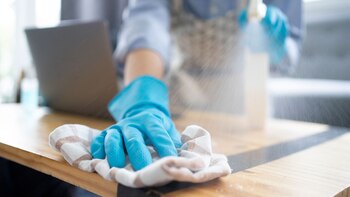
The fear generated by COVID-19 led many people to become aware of the importance of disinfecting surfaces to prevent coronavirus and other respiratory diseases.
More than two years after the pandemic was declared by the World Health Organization (WHO), and in the middle of the influenza season in the southern hemisphere, a new research was released from scientists from the Doherty Institute, who tested the effectiveness of the ability of common household cleaning products to inactivate SARS-CoV-2 on surfaces.
They showed that detergent, bleach and alcohol are very effective. Not so does vinegar, so used in household cleaning but without effect for these purposes, as the researchers saw.
Published in the latest edition of Viruses by MDPI, the research led by Dr. Julie McAuley of the University of Melbourne, researcher at the Peter Doherty Institute for Infection and Immunity (Doherty Institute) is one of the first studies in focus testing on common cleaning with chemicals normally found in the home and used to disinfect surfaces.
And since home isolation remains the key tool to reduce the transmission of COVID-19, the need for scientific findings demonstrating the effectiveness of common household cleaning products became imperative.
To address this issue, Dr. McAuley's research team tested the ability of cheap and readily available household cleaning products to render SARS-CoV-2 non-infectious, which included vinegar, bleach, dishwashing detergent and ethanol to represent the alcohols available in the household.

“Our findings show that detergent, bleach and alcohol are very effective in making SARS-CoV-2 non-infectious, but vinegar doesn't work at all,” McAuley concluded.
The findings of the study revealed the minimum concentration at which users can dilute the household cleaning product and still inactivate SARS-CoV-2.
“To make an effective cleaning solution, it's as simple as adding a similar amount of detergent to the water as you would with your dishes (2 ml in 1 liter), then wiping the potentially SARS-CoV-2 contaminated surface with a cloth and letting it dry,” McAuley said. For bleach, as little as 5 ml can be added to 1 liter of water and could be ideal for disinfecting bathroom surfaces. Alcohol-containing hand soaps, or solutions used to clean surfaces, must contain more than 40% alcohol to be effective.”
Engineer Martín Piña, director of the Food Engineering career at Fundación UADE, marked the differences between cleaning and disinfecting before Infobae's consultation. “When you clean, you wipe, sweep, or vacuum to remove visible dirt, but if you don't disinfect you don't kill viruses or bacteria,” he explained.
In addition, he detailed what the correct method of cleaning should be: “First you have to clean and then disinfect with a chemical agent, which may be alcohol or bleach.”
“Alcohol sold in pharmacies is 96° and is proven to have a better bactericidal action at 70%, so the ideal is to dilute 70 milliliters of alcohol in 30 ml of water and thus it will be much more effective than 96”, stressed the specialist.
Thus, for greater practicality when cleaning, a 70% alcohol dilution can be placed in a sprayer to have at your disposal without having to prepare each time.

Regarding lavandina, a product that is also proven to eliminate this and other viruses and bacteria, Piña advised “always read the label to see the concentration of chlorine that each brand contains and dilute according to each concentration”.
“To wash your hands, soap and water are best, always following the steps and recommendations of the WHO regarding how long the wash should last,” said the specialist.
One caveat that Piña made with respect to each of these chemical agents, is that “alcohol evaporates and is not toxic, while lavandine must then be rinsed with water”.
The study also tested whether the combination of household products would increase their effectiveness and found that there was no benefit. And contrary to what one might believe, in this case also less is more.
“Surprisingly, when we combined bleach and detergent, we didn't see a greater virucidal potential to inactivate SARS-CoV-2 compared to using each component separately,” McAuley said.
In conclusion, he warned: “We should also point out against combining chemicals in an attempt to increase their virucidal activity, as some household disinfectants contain buffering agents that we find can counteract the effective virucidal concentration of the other chemical with which it was mixed.”
KEEP READING
Últimas Noticias
Debanhi Escobar: they secured the motel where she was found lifeless in a cistern
Members of the Specialized Prosecutor's Office in Nuevo León secured the Nueva Castilla Motel as part of the investigations into the case

The oldest person in the world died at the age of 119
Kane Tanaka lived in Japan. She was born six months earlier than George Orwell, the same year that the Wright brothers first flew, and Marie Curie became the first woman to win a Nobel Prize

Macabre find in CDMX: they left a body bagged and tied in a taxi
The body was left in the back seats of the car. It was covered with black bags and tied with industrial tape
The eagles of America will face Manchester City in a duel of legends. Here are the details
The top Mexican football champion will play a match with Pep Guardiola's squad in the Lone Star Cup

Why is it good to bring dogs out to know the world when they are puppies
A so-called protection against the spread of diseases threatens the integral development of dogs




